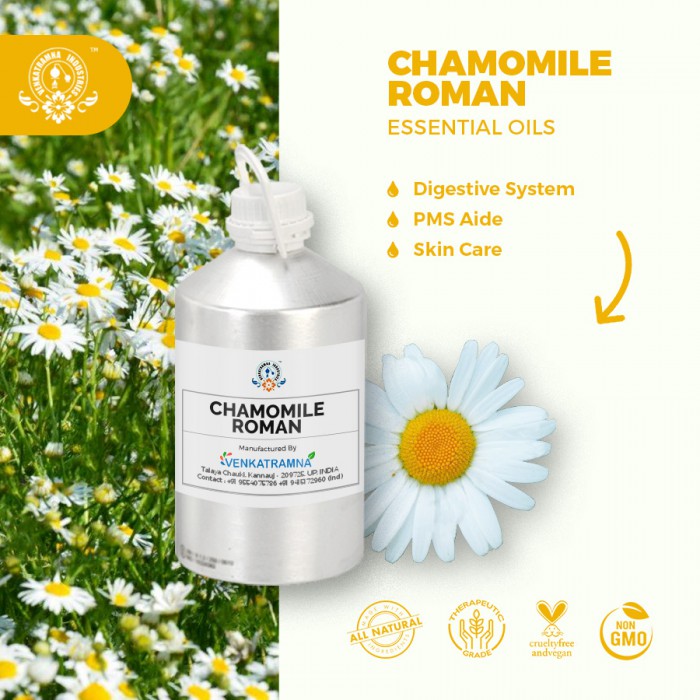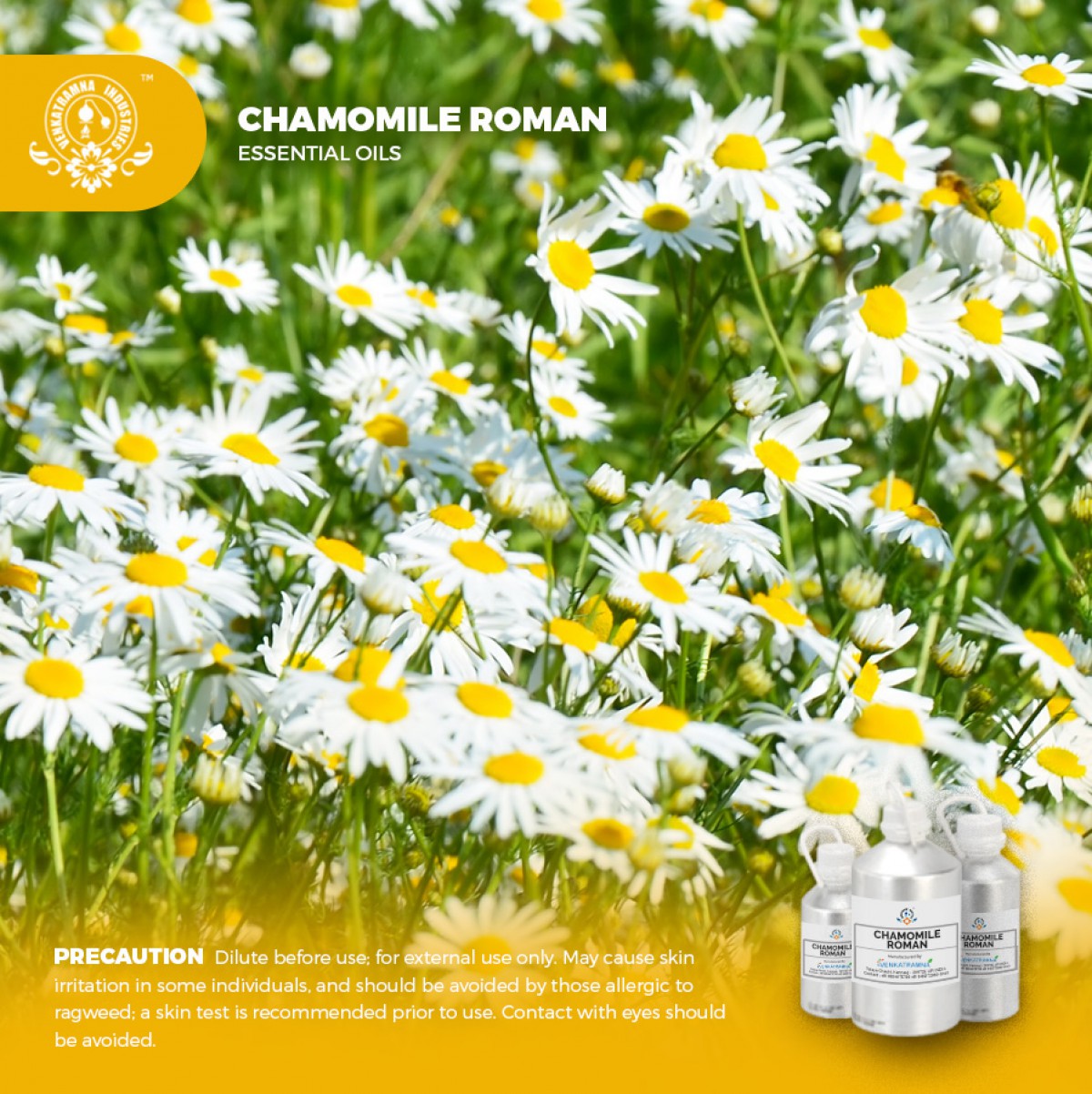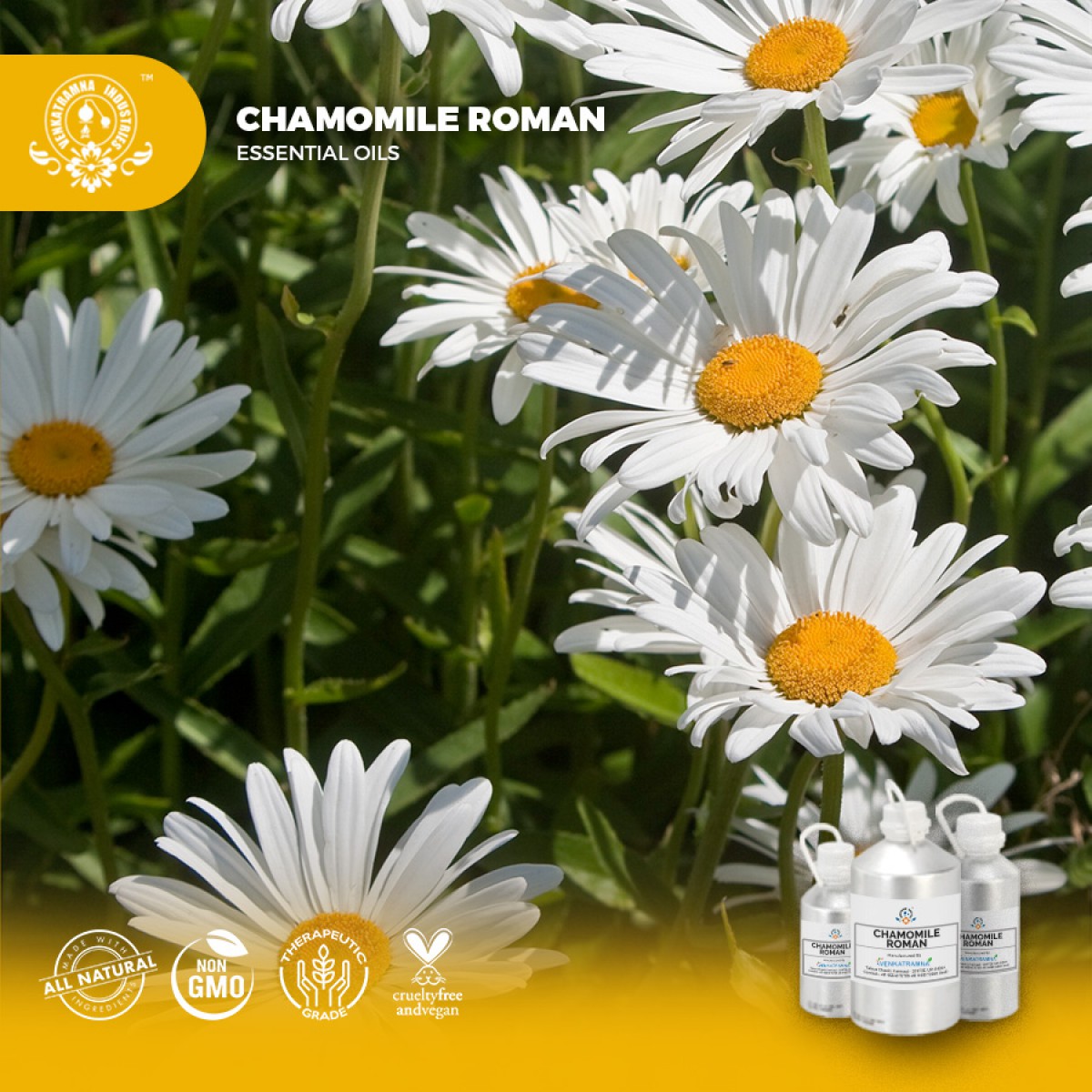Botanical Name: Anthemis nobilis L. Common name: Roman chamomile, English chamomile Read More
|
Botanical
Name: |
Anthemis nobilis L. |
|
Common name: |
Roman chamomile, English chamomile, garden chamomile, ground
apple, low chamomile, mother's daisy or whig plant |
|
Plant family: |
Asteraceae |
|
Genus: |
Tanacetum |
|
Appearance/Color: |
A thin light bluish to yellow liquid. |
|
Odor: |
A strong middle note, roman chamomile has a fragrance like apples
and sweet straw, and is considered the finest smelling of all chamomiles. |
|
Blends With: |
Bergamot, clary
sage, lavender, geranium, jasmine, neroli, patchouli, tea tree, rose, lemon
and ylang-ylang. |
|
Origin |
Rome |
|
Source |
Flower |
|
Method of
Extraction |
Steam Distillation |
Chamomile is a plant that has
been used since ancient Egypt in a variety of healing applications. Chamomile
is a native of the Old World; it is related to the daisy family, having
strongly scented foliage and flowers with white petals and yellow centers. The
name chamomile is derived from two Greek words that mean “ground” and “apple,” because
chamomile leaves smell somewhat like apples, and because the plant grows close
to the ground.
There are two varieties of
chamomile commonly used in herbal preparations for internal use and
for aromatherapy. One is called Roman chamomile (Anthemis nobilis), with
contemporary sources in Belgium and southern England. Roman chamomile grows to
a height of 9 in (23 cm) or less, and is frequently used as a ground cover
along garden paths because of its pleasant apple scent. German
chamomile (Matricaria recutita) is grown extensively in Germany,
Hungary, and parts of the former Soviet Union. German chamomile grows to a
height of about 3 ft (1 m) and is the variety most commonly cultivated in
the United States, where it is used medicinally.
There are several types of
chamomile essential oil used in aromatherapy, and this makes it vital to choose
the correct type of oil for the therapeutic properties that is required. Roman
chamomile essential oil is the most popular ot the tree types of chamomile oils
used in aromatherapy, possibly due to its vast range of healing properties and
amazing versatility. Most people seem to prefer the fragrance of roman
chamomile oil to that of either the German or Maroc, and it certainly blends
well with a very wide range of essential oils.
The Latin name for roman chamomile is most commonly given in aromatherapy and botanical books as anthemis nobilis (Linnaeus), but there has been a growing trend of late to refers to this plant as chamaemelum nobile. Both names are correct and do refer to the same plant and not a different sub-species.
DISCLAIMER
The complete range of conditions
or methods of use are beyond our control therefore we do not assume any
responsibility and expressly disclaim any liability for any use of this
product. Information contained herein is believed to be true and accurate however,
all statements or suggestions are made without warranty, expressed or implied,
regarding accuracy of the information, the hazards connected with the use of
the material or the results to be obtained from the use thereof. Compliance
with all applicable federal, state, and local laws and local regulations
remains the responsibility of the user.
The FDA has not evaluated the
statements on this website. No claims are made by Venkatramna Industries as to
the medicinal value of any products from vriaroma.com or by us. The information
presented here is for educating our customers about the traditional uses of
essential oils and is not intended to diagnose, treat, cure, or prevent any
disease. You are responsible for understanding the safe application of these products.
If you have any questions, please call or email us for further information.
As per NAHA guidelines, New Directions Aromatics (NDA) does not recommend the ingestion of essential oils. It is imperative to consult a medical practitioner before using Essential Oils for therapeutic purposes. Pregnant and nursing women and those taking prescription drugs are especially advised not to use this product without the medical advice of a physician. The oil should always be stored in an area that is inaccessible to children, especially those under the age of 7.
Chamomile has been used
internally for a wide variety of complaints. The traditional description of
chamomile is alles zutraut, which means that the plant “is good for
everything.”
Chamomile Essential Oil in
Pharma
Chamomile has been used for the
following purposes, in pharmaceutical and ayurvedic industries to treat the
following medical conditions:
Antispasmodic: A
preparation given to relieve intestinal cramping and relax the smooth muscles
of the internal organs. Chamomile is used as an antispasmodic to relieve
digestive disorders, menstrual cramps, premenstrual syndrome (PMS), headache,
and other stress-related disorders.
Anthelminthic: Chamomile
has been used to expel parasitic worms from the digestive tract.
Carminative: Chamomile is
given to help expel gas from the intestines.
Sedative: Perhaps the most
frequent internal use of chamomile is in teas prepared to relieve anxiety and
insomnia.
Anti-inflammatory: Roman
chamomile has been used to soothe the discomfort of gingivitis (inflamed gums),
earache, and arthritis. German chamomile is used in Europe to treat oral
mucosities in cancer patients following chemotherapy treatment.
Antiseptic: Chamomile has
mild antibacterial properties and is sometimes used as a mouthwash or eyewash.
It can be applied to compresses to treat bruises or small cuts.
Essence of Chamomile Essential
Oil
The external uses of chamomile include
blending its essential oil with lavender or rose for scenting
perfumes, candles, creams, or other aromatherapy products intended to calm or
relax the user. Chamomile is considered a middle note in perfumery, which means
that its scent lasts somewhat longer than those of top notes but is less long
lasting than scents extracted from resinous or gum-bearing plants. Chamomile is
also a popular ingredient in shampoos, rinses, and similar products to add
highlights to blonde or light brown hair.
COMMON USAGE
·
Removes toxic agents
·
Prevents infections
·
Relieves depression
·
Reduces anger
·
Improves digestion
·
Treats rheumatism
·
Skin care
·
Relieves pain
·
Removes excess gas
·
Boosts nervous system
·
Tones the body
Ingredients:
S.No | Key Constituents | Strength (%) |
1 | Isobutyl angelate | 0-37.4 |
2 | Butyl angelate | 0-34.9 |
3 | 3-Methylpentyl angelate | 0-22.7 |
4 | Isobutyl butyrate | 0-20.5 |
5 | Isoamyl angelate | 8.4-17.9 |
6 | 2-Methyl-2-propenyl angelate | 0-13.1 |
7 | 3-Mrthylpentyl isobutyrate | 0-12.5 |
8 | 2-Methyl-2-propyl angelate | 0-7.4 |
9 | camphene | 0-6.0 |
10 | Borneol | 0-5.0 |
11 | a-pinene | 1.1-4.5 |
12 | a-terpinene | 0-4.5 |
13 | chamazulene | 0-4.4 |
14 | (E)-pinocarveol | 0-4.4 |
15 | a-thujene | 0-4.1 |
16 | Hexyl butyrate | 0-3.9 |
17 | terpinolene | 0-3.9 |
18 | Isobutyl isobutyrate | 0-3.7 |
19 | anthemol | 0-3.2 |
20 | g-terpinene | 0-3.2 |
21 | Isoamyl isobutyrate | 0-3.1 |
22 | d-3-carene | 0-2.8 |
23 | Isoamyl 2-methylbutyrate | 0-2.8 |
24 | 2-methylbutyl 2-methylbutyrate | 0-2.7 |
25 | Isoamyl butyrate | 0-2.6 |
26 | Pinocarvone | 0-2.4 |
27 | b-Myrcene | 0-2.1 |
28 | p-cymene | 0-2.0 |
29 | b-pinene | 0.2-1.6 |
30 | Isoamyl methacrylate | 0-1.5 |
31 | b-phellandrene | 0-1.4 |
32 | Propyl angelate | 0-1.1 |
TOXICOLOGICAL
INFORMATION
·
Hazards none known.
·
Contraindications none known.
Organ-specific
effects No information found for any chamomile oil.
Urinary
effects administration of 350 mg/kg of roman chamomile oil to rats by SC or
IP injection resulted in decrease in water elimination from 93.04% to 46.85%
and 28.10% of the water administered. The major constituents of this oil were
butyl angelate and isoamyl angelate. Nothing meaningful can be extrapolated
from the massive does used he.
Systemic
effects
Acute
toxicity Roman chamomile oil acute oral LD50 in rats>5 g/kg; acute
dermal LD50 in rabbits>5 g/kg.
Antioxidant/pro-oxidant
activity
Roman
chamomile oil showed moderate antioxidant activity as a DPPH radical scavenger
and low activity in the aldehyde/carboxylic acid assay.
Carcinogenic/anticarcinogenic
potential
Roman
chamomile oil was not mutagenic in either a bacillus subtilis rec-assay or an
Ames test. Chamomile oil significantly induced glutathione-S-transferase
activity in mouse tissues. Roman chamomile oil contains no known carcinogenic
·
Toxicity: No additional data available.
·
Persistence & degradability: No additional
data available.
·
Bioaccumulation Potential: No additional data
available.
·
Mobility in soil: No additional data available.
·
Results of PBT and vPvB Assessment: No additional
data available.
·
Other adverse effects: Do not allow product to
enter streams, sewers or other waterways.





 MSDS-Chamomile5.pdf
MSDS-Chamomile5.pdf




